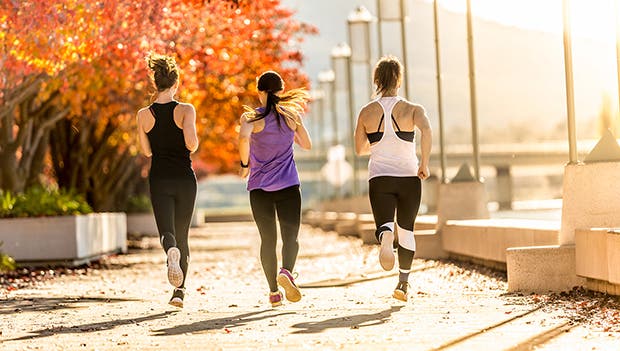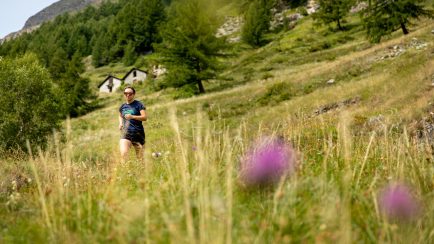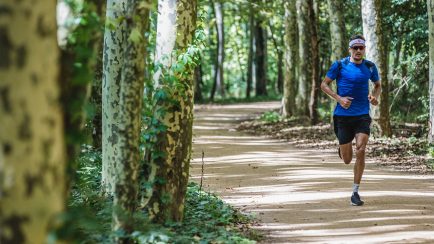With any activity, attire is essential. So when it comes to running and the weather conditions, it can be tricky to figure out what to wear when the sun is scorching or snow is falling. We'll take it season by season and apparel piece by piece. Read on to figure out the perfect running attire for any weather.

In any season, there's a lot to consider to find right running shoe. The proper shoe can change depending on whether it's an easy run, long run, or sprint workout.
Summer
A sunny 75-degree day can be perfect for a sweaty run. My running rule for summer runs is "if the suns out, I'm not." In order to enjoy my run and not suffer heatstroke, I go out early in the morning or later after the sun goes down. These times are cooler and perfect for a light sweat jog. Truthfully though, because the summers are always warmer no matter when you go, I always wear the same attire.
Sunglasses: Great for keeping the sun out of your eyes. They also give you more energy to allow your face to relax and not squint from the sun.
Singlet: A loose-fitting top is great to help airflow through your core. They can also be a great sweat rag for when and if you have the sun beating down on you.
Sports Bra: Well just to keep the girls secure. Sometimes I choose to just run in a sports bra and shorts if the day is too hot by the time I head out.
Shorts or Compression Shorts: Most running shorts have spandex underneath the short design, so both work well. I prefer to wear just spandex because they help with chaffing and hold tight onto my body.
Sunblock: This will actually keep you cooler and reduces your risk of skin cancer.
Fall & Spring
These seasons are hands down my favorite time to run. I think most runners can agree with this. 'Tis the seasons that are in between too hot or too cold. The temperatures are chilly enough to work up a good sweat without feeling like you're boiling in the summer sun or screaming in the winter chill. For both, the weather is a bit cooler in the mornings. The best time to run is closer to 11:00 when the sun has had its chance to warm the air a bit. It also depends on whether you're a "top" or "bottom sweater."
Baseball Cap: Though it's not cold enough for a knit hat, a baseball cap will do the job if you have a head that gets chilly. It's also great because though the sun isn't as strong in the fall, it will protect your face from UV rays.
Long Sleeve: If you're a "top sweater" you might want to stick with your summer singlet. I for one, am not. My top half is always colder than my bottom. I generally head out for my runs in the morning when the air is still crisp. I wear a light long sleeve that breathes so I don't overheat.
Shorts or Leggings: If you're a "bottom sweater" stick with shorts. Don't buy cotton leggings because they will "pill" and may overheat your legs. Instead, purchase a pair that is wick or spandex material.
Winter
Winter can be the toughest season to dress for. Of course, if there's snow falling you'll think you need to bundle up. But then you'll get a few miles out and be so hot you'll double your sweat count. The trick to running in cold weather is to wear layers of lightweight attire. This way if you do overheat you can take one layer off at a time without having a drastic temperature shift. Many runners get very sick when they dress too warm for cold winter runs. This is because once their body reaches a warm temperature they actually get cold sweats which, combined with the cold season, results in sickness.
Light Jacket: Preferably windproof because the frigid winter air can be harsh. A polyester blend jacket serves perfectly to keep you warm and keep off wind, rain, and snow. I suggest wearing a full zip jacket so you can use it to gauge your temperature and zip up or down when needed.
Long Sleeve Shirt: Shoot for a high-tech polyester long sleeve shirt. This material pulls moisture away from your skin, keeping you from getting the cold sweats. A long sleeve under a jacket is great in case you do get too hot in the jacket; you can tie it around your waist and the temperature shift isn't too drastic that you get too cold.
Gloves: Always wear or bring gloves along with you in the winter. They are so lightweight and easy to stuff in your pockets. If you're anything like me and your hands and feet run cold no matter the temperature, then you'll definitely want these on deck.
Tights: This is the base of a good layering strategy. Wearing tighter leggings provides your legs with insulin and doesn't provide your legs with a "windy" chill. In extreme temperatures, you can wear a looser pant over the leggings and they can be easily removed if you start to warm up as the miles rack on.
Ear Warmers: Same as my hands and feet, my ears are always frigid on a winter run. The best kind of ear-warmers for a run is the headband versions. They work well for keeping your hair out of your face and your ears toasty warm.
Which is the Best Season to Run in?
EVERY SEASON! No matter the weather we hope this blog was helpful for you to dress in the perfect running attire for any weather.




